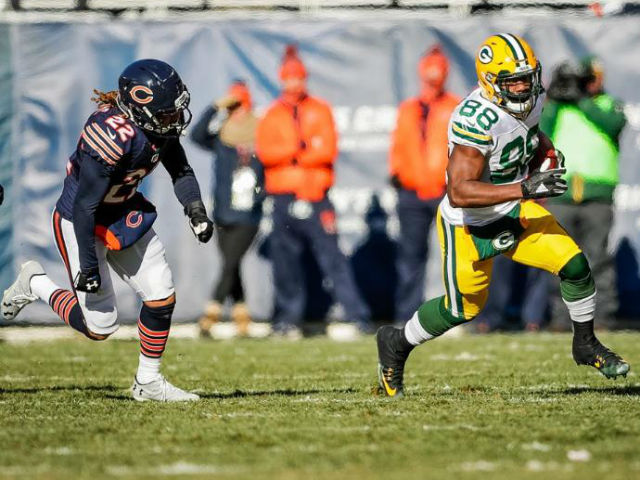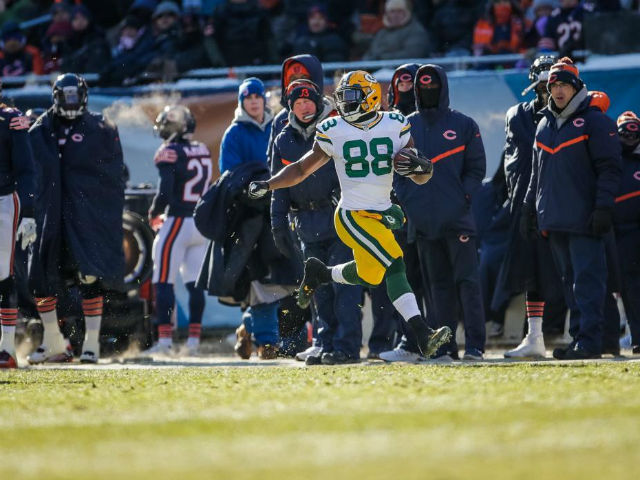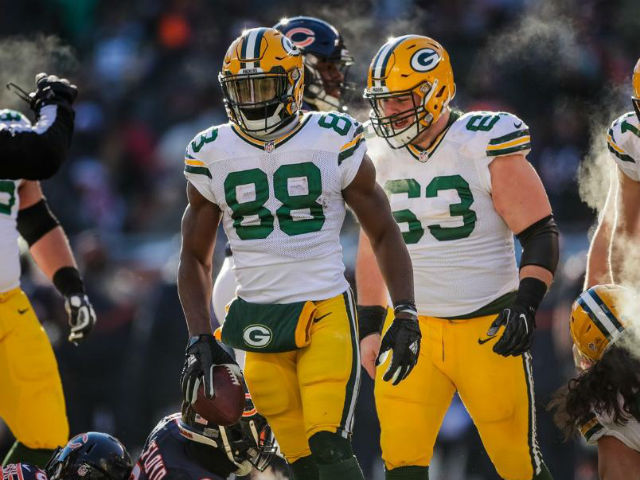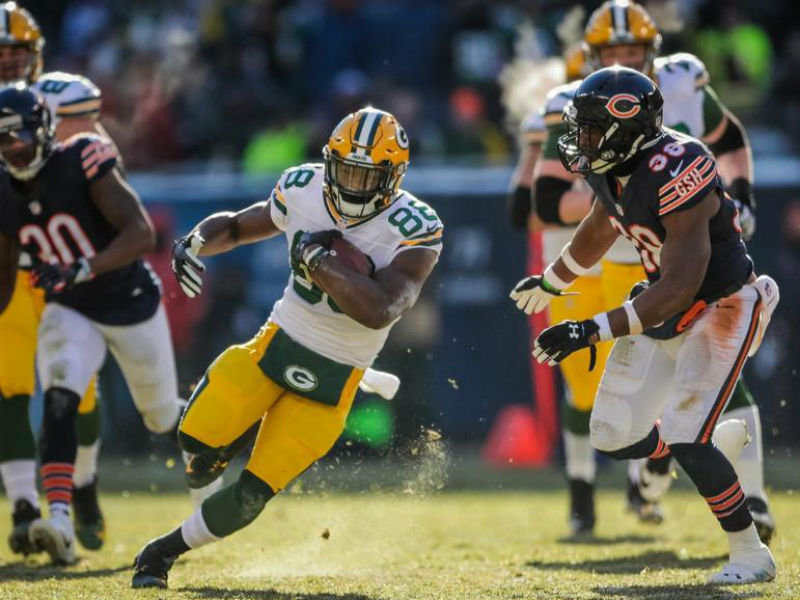GREEN BAY – Spend enough time talking to Ty Montgomery, the Packers’ second-year wide receiver-turned-running back who rushed for 162 yards and two touchdowns Sunday against the Bears and attracted national attention for that position-switch breakout game, and a few things become clear.
First, he might be the most agreeable, non-diva receiver that’s ever played in the NFL; maybe that’s because he’s not really a wide receiver and just does whatever he’s asked to do to help his team. Second, his success as a running back didn’t surprise him – or his teammates – in the least, even if it shocked most everyone else; it’s a product of preparation, he says, and teammates insist they saw this coming. Third, unlike most receivers, he doesn’t mind contact with defenders; in fact, he really, really likes breaking their tackles.
But to understand those things – and how and why they’ve converged seemingly all of a sudden to create an unexpected but all-important Packers running game – we first need some of Montgomery’s background as context. Let’s try and get through this as quickly as possible, gleaning just the most relevant stuff, before catching up to the present and then looking to the future, as Montgomery has already done.
A running back originally at St. Mark's School of Texas in Dallas, Montgomery switched to wide receiver late in his high school career because his coach, citing the team’s pass-first offense as a better beneficiary of his talent, requested it. And when recruiters started showing up, Montgomery figured, "Well, if they see me play receiver, if it ain't broke, don't fix it." He went to college camps as a receiver, though he still saw himself as a runner.
In four years at Stanford, Montgomery rushed the ball only 39 times – gaining an average of 8.6 yards per carry – compared to 172 receptions for 2,125 yards and 15 touchdowns, plus five total scores as a dynamic return man. It was for those latter roles that Ted Thompson drafted him in the third round of the 2015 NFL Draft, but the Packers’ general manager did tellingly note that Montgomery was a "very strong runner, very instinctive, has good quickness … and I think the key thing is his strength level is better than most." One team scout said he was a "bigger" Randall Cobb.
Montgomery was given jersey No. 88, which while not exclusively a wide receiver’s number – it was worn most recently in Green Bay by tight ends Jermichael Finley and Bubba Franks – is decidedly not that of a running back. And during his rookie season last year, as he battled a serious ankle injury that frustratingly limited him to only six games, Montgomery had 15 receptions and just three rushing attempts. Following surgery, he headed into 2016 confident he could contribute.
But after a slow recovery, this season started inauspiciously. After four games, Montgomery had played only 11 snaps as a wide receiver and a handful as a running back, along with some opportunities as a returner. For the most part, he was a nonfactor, but the Packers were 3-1, so he wasn’t griping.

Then, in mid-October, things started to change, for team and player. With Aaron Rodgers struggling – you remember those doom’s-day stories, right? – and his receivers unable to get open downfield, Green Bay reformatted itself as a more spread-out, short-passing-game attack. While it looked dispiritingly different than the characteristic big-play Packers offenses, the style fit Montgomery perfectly – arguably better than anyone else on the roster – and highlighted what he does best: getting the ball in space, finding holes, making defenders miss, breaking tackles and gaining yards after the catch.
In a Week 6 loss to the Cowboys, Montgomery played 35 snaps and had 10 receptions for 98 yards, both of which were career highs. Six of his catches for 52 yards were as a runner out of the backfield; he was the only Packer that posed any threat against Dallas.
By Week 7, both Lacy and Starks were out with injuries. But in the Oct. 20 win over the Bears, Montgomery played 60 snaps. Again, he had 10 receptions, but this time also added nine carries for 60 yards. The 19-touch, 126-yard performance reaffirmed Montgomery as a truly dangerous, multi-dimensional player and suggested he could be a difference-maker for Green Bay’s languishing offense.
And yet even with their only true running backs sidelined – Starks missed a month and Lacy would ultimately be placed on season-ending injured reserve – the Packers didn’t turn to Montgomery as the solution. They tried several options in the backfield – trading for and quickly releasing Knile Davis, promoting from the practice squad and then placing on IR Don Jackson, using Rodgers and Cobb and fullback Aaron Ripkowski too much as ball-carriers – with little to no success.
Montgomery missed the Oct. 30 loss to the Falcons because of a sickle cell trait-related illness, but returned shortly afterward. Still, from Weeks 8-11, Green Bay went 0-4, looking inept and lacking a functional running game. Starks returned in Week 10 but was ineffective, further muddling the position. Thompson signed Christine Michael, who’d been Seattle’s leading rusher before being waived, but he provided nothing for a month.
It wasn’t until the calendar flipped to December and the Packers had to play their first game in snow – perhaps it was a reminder to head coach Mike McCarthy about the necessity of a running game in winter – that Montgomery got a real chance. On Dec. 4, he carried six times for 40 yards (6.7 average), as Green Bay ground out a 21-13 home win over Houston. The next week, with the Packers hosting the defensively imposing Seahawks at Lambeau Field, Montgomery rushed nine times for 41 yards (4.6) and a touchdown.
It’s not easy, nor desired, at this level of professional football to change positions, even for a player with some experience. But Montgomery never complained or questioned the transition; it was what his coaches wanted and what his team needed.
"There were no talks," Montgomery said Wednesday of whether there were indications in advance of the switch that he might have to take on a bigger backfield role. "I just always did what I was asked to do."
A day after the Seahawks game, McCarthy let the public in on the Packers’ little non-secret, saying, "Ty Montgomery is a running back. … I apologize for not making an announcement. He hasn't gone to a receiver meeting in months."
In Sunday’s win at Chicago, Montgomery rushed for more yards than any Green Bay player since 2005; his 10.13 yards per carry was the third-highest average in franchise history, dating back to 1960. The Packers’ 9.8 average – 226 yards on 23 carries – was their best as a team, on at least 15 attempts, since 1933. Michael chipped in four carries for 45 yards (11.3) and a touchdown.

In the 30-27 win over the Bears, Montgomery broke three big runs of at least 25 yards, including a 61-yarder that was one of the most exciting plays of the year. In it, he initially looked like he would be stopped for a two-yard loss, but Montgomery ducked and spun away from a couple of Chicago defenders, broke a couple more tackle attempts and then sprinted up the sideline. It showcased his unique ability – a difficult-to-describe combination of vision, balance and compact strength – to absorb hits and keep moving forward.
"That’s one of the things I try to do," Montgomery said, before launching into a litany of his new responsibilities, which now include pass blocking. "Finishing runs, breaking tackles – we talk about that a lot – ball security, protecting the quarterback, knowing my assignments, winning my one-on-one battles."
Listed at 6-feet and 216 pounds – teammates call him 220 – Montgomery gained 98 of his 162 yards after first contact, according to ESPN Stats & Information, including all 61 on that long run. He averaged 6.13 yards per carry after contact against the Bears.
Afterward, Montgomery offered no earth-shattering explanations for what he’d achieved. "That’s just what we’re coached to do. That’s how I was raised as a kid. It’s just ingrained in me," he said, before throwing praise on his blockers. One of them, right guard T.J. Lang, had a different opinion, saying, "Honestly, I felt like half of Ty’s runs, he was just breaking tackle after tackle; it seemed like we didn’t really have to block anybody in order for him to squirt out of there."
For the season, Montgomery’s 3.68 average yards per carry after first contact is the best among all NFL running backs with at least 60 attempts. After the Week 15 game, he moved past Lacy – who hasn’t played in two months due to injury, demonstrating the team’s impotence running the ball this year – as the Packers’ leading rusher with 390 yards on 60 attempts (6.5 average). In one week, with its 226-yard outing, the team moved up from 23rd to 15th overall in the league rushing rankings.
16 carries.
162 yards.
2 TDs.@TyMontgomery2 = 💪 💪 in #GBvsCHI.#GoPackGo https://t.co/6Dxv3YNCDk — NFL Now (@NFLNow) December 19, 2016
Left guard Lane Taylor said Wednesday that Montgomery’s production was not surprising, given what the team has seen him do in practice, but the resulting improvement of the running game was significant.
"To have a day like that is obviously nice and rewarding; we haven’t had a day like that all year, so it was great to have it," Taylor said. "But just the way (Montgomery’s) been, he’s been progressing all year long. Obviously kind of got thrust into the running back role this year and he’s doing a good job with it.
"It’s nice, instead of always pass blocking all the time, it takes a little pressure off everyone else, off Aaron and the receivers and us. Being more balanced is bigger than anything, and keeping the defense honest."
Cobb, who has 10 carries for 33 yards this season and didn’t have a catch against Chicago, echoed Taylor’s comments. He added that Montgomery also creates schematic mismatches since defenses worried about him catching the ball out of the backfield have to decide whether to use a linebacker on him or a defensive back, which advantageously changes formations and coverages.
"I think at this point you don’t really get too surprised too often. You see guys make flash plays like that all the time," Cobb said. "But to do it with the consistency that he did this past week was huge, and we’re going to need that going forward."
On Monday, both quarterback and coach spoke in similar ways about Montgomery’s running style and success.
Said Rodgers: "I think people don’t understand how built he is. He’s a compact 220-pound guy who has good quick-twitch, but he’s also got a really good stiff-arm. He had a number of yards after contact, which says a lot about his ability to make something out of sometimes not much."
Said McCarthy: "I think you look at the way he’s built and his talent and patience. A lot of times, the great runners, both yards after the catch and yards after contact, it’s the ability to stay patient and keep stepping through those tackles, especially on that type of surface. He’s a lot stronger than I think people realize."

"I think he just showed he has a lot of will to not go down on first contact. That kind of separates the good running backs from the rest of the running backs, just that will to get extra yards, stay on your feet, continue your runs," Taylor said. "He’s a pretty stout guy, he’s about 220 pounds, and he’s pretty jacked up. He plays balanced and is pretty powerful, able to knock guys off him."
Added Cobb: "He’s done a great job with the transition, making plays, but it comes down plain-and-simple to hitting the holes, breaking tackles and making guys miss, and he does that as well as anyone on this team."
Standing at his locker in front of a swarm of reporters on Wednesday, Montgomery said his body didn’t feel any different after Sunday’s game and he was certain he could consistently handle an increased workload. He embraced being a running back. It fit his mentality; it fit the way he plays football.
"One of the things I didn’t really like so much about playing receiver is you can’t always run after the catch," Montgomery said in a brief moment of prized candor. "I didn’t really like catching the ball and trying (to get) two feet inbounds; I always wanted to run and break tackles.
Montgomery said he thought about his Stanford days, when he took a lot of screen passes and relished the opportunity to "knife through the middle of the defense." There was no hesitancy in changing positions, nor the extra physical contact. "I wasn’t worried about any of that," he said.
When asked Wednesday if he had a favorite run from Sunday’s game, the always-understated Montgomery was unwilling, or merely indifferent, to extolling his own accomplishments.
"I guess not," he said of whether he evaluated his plays in such ways. "I was just doing what I was told."
Montgomery said it didn’t take long for him to feel like a real running back. When pressed about the challenges of switching positions, and thereby the aptitude he must possess to do so, the 23-year-old was similarly subdued: "Yeah, they are two different positions, but for me it’s still football."
OK, but are you at least enjoying the new, expanded role?
"I am, I really am," he admitted. "It’s a lot of fun to be able to contribute in more ways than I was able to before because I like to be able to contribute and to be helpful in any way that I can. So I’m grateful for that and I’m also grateful for the wins we’ve been able to get."
With Rodgers hampered by lingering hamstring and calf injuries that he’s said probably will affect him the rest of the season, and cold weather always inclining offenses more toward rushing the ball, Montgomery’s emergence as a true running back could not have come at a better time. The Packers are preparing for their final two, must-win games of the season against division rivals Minnesota and Detroit.
Despite appearing to be the crucial missing piece to the Packers’ suddenly humming offense – they’re averaging 29 points over their current four-game winning streak – the unassuming-but-thoughtful Montgomery doesn’t believe he needs to have the kind of monster day he had in Chicago for the team to be successful.
"My thing is I’m going out there trying to be the very best that I can be, but I’m not trying to live up to any numbers," he said. "I have a standard that I’m always trying to meet, but the numbers aren’t always going to be that standard. It’s about how I play the game, how I execute things, my fundamentals, my technique.
"And if the numbers end up being as high as they were, I’m grateful. But to try to be realistic, I don’t think I’m going to put up 160-some rushing yards every single game. I mean, it’d be nice to – I strive for it, I’m not going to rule it out – but that’s not something I’m going to try and live up to."
Montgomery said he spends his preparation time watching game tape of not only opposing defenses, but also of fellow running backs, especially in order to learn the nuances of pass protection, which he said has been one of the biggest changes. It’s a new responsibility – one that he said did not come naturally but hasn’t been too difficult. Montgomery couldn’t think of any other receivers who’d successfully switched to a featured-back role; he said he’s watched a lot of running backs and leaned on teammates Lacy and Starks for guidance.
"Eddie and James were big helps, they were big influences," he said. "Just asking a lot of questions, watching their runs, those are two backs who’ve been successful in Green Bay, and I was able to watch them and learn from them."
Without divulging details, Montgomery added that Lacy was "proud" and "excited" for him after his huge game against the Bears, a performance that garnered tons of social media attention, including that of rapper Lil Wayne.
I may very well name my next kid or album TY Montgomery!! Girl or boy!!
— Lil Wayne WEEZY F (@LilTunechi) December 18, 2016 Of course, Montgomery modestly shrugged off the tweet, saying he appreciated it but doesn’t look to public acclaim as a source for confidence. "I learned one thing from a pastor we had at the chapel: all praise goes to God and all criticism comes from God, and all criticism is constructive, so I don’t worry too much about what’s being said concerning me."
And Montgomery was just as macro-minded when asked to contrast his challenging rookie year with this more positive second season: "I guess my response to that would be adversity is just based on perspective. My adversity was a little different then, so my perspective was a little different. Comparing the two is unfair."
Another comparison Montgomery didn’t want to make was to other receivers’ running styles. "I don’t really want to be the one that groups all receivers into one category. I mean, there’s different types of runners out there," he said. "Nothing against these guys, I think all three of these guys I’m going to name are great, but Steve Smith probably runs the ball a little bit differently than Anquan Boldin when he gets the ball versus Odell Beckham, but they’re all effective at the wide receiver position. So to try and group all wide receivers together in terms of how they run the football, I don’t think is really fair and then to try and correlate that into transitioning into the running back position, I don’t know if you can really do that."
After this season, Lacy is a free agent and his injury and weight issues have raised questions about his long-term value. Starks is currently signed for 2017, but Green Bay could release him without taking much of a salary-cap hit. Montgomery is already a better change-of-pace back for the pounding Lacy than Starks was, and the 31-year-old veteran has shown this season that he’s got virtually nothing left in the tank. It’s possible the Packers could bring back Lacy next year to partner with Montgomery as a different thunder-and-lightning combo; even if he’s proven he’s more than a gimmicky gadget option, it’s still hard to imagine Montgomery being a 15-20 carry lead back.
So maybe next year he’ll have a corresponding new jersey number, since players can’t change midseason. Last week, McCarthy said Montgomery is "not really No. 88." Indeed, that wide receiver jersey currently belongs to a running back – right now the best one Green Bay has, perhaps the key to its playoff hopes. And anyways, what's in a number? That which we call a running back, by any other number would rush as sweet.
The Packers host the Vikings at noon on Saturday.


Born in Milwaukee but a product of Shorewood High School (go ‘Hounds!) and Northwestern University (go ‘Cats!), Jimmy never knew the schoolboy bliss of cheering for a winning football, basketball or baseball team. So he ditched being a fan in order to cover sports professionally - occasionally objectively, always passionately. He's lived in Chicago, New York and Dallas, but now resides again in his beloved Brew City and is an ardent attacker of the notorious Milwaukee Inferiority Complex.
After interning at print publications like Birds and Blooms (official motto: "America's #1 backyard birding and gardening magazine!"), Sports Illustrated (unofficial motto: "Subscribe and save up to 90% off the cover price!") and The Dallas Morning News (a newspaper!), Jimmy worked for web outlets like CBSSports.com, where he was a Packers beat reporter, and FOX Sports Wisconsin, where he managed digital content. He's a proponent and frequent user of em dashes, parenthetical asides, descriptive appositives and, really, anything that makes his sentences longer and more needlessly complex.
Jimmy appreciates references to late '90s Brewers and Bucks players and is the curator of the unofficial John Jaha Hall of Fame. He also enjoys running, biking and soccer, but isn't too annoying about them. He writes about sports - both mainstream and unconventional - and non-sports, including history, music, food, art and even golf (just kidding!), and welcomes reader suggestions for off-the-beaten-path story ideas.







